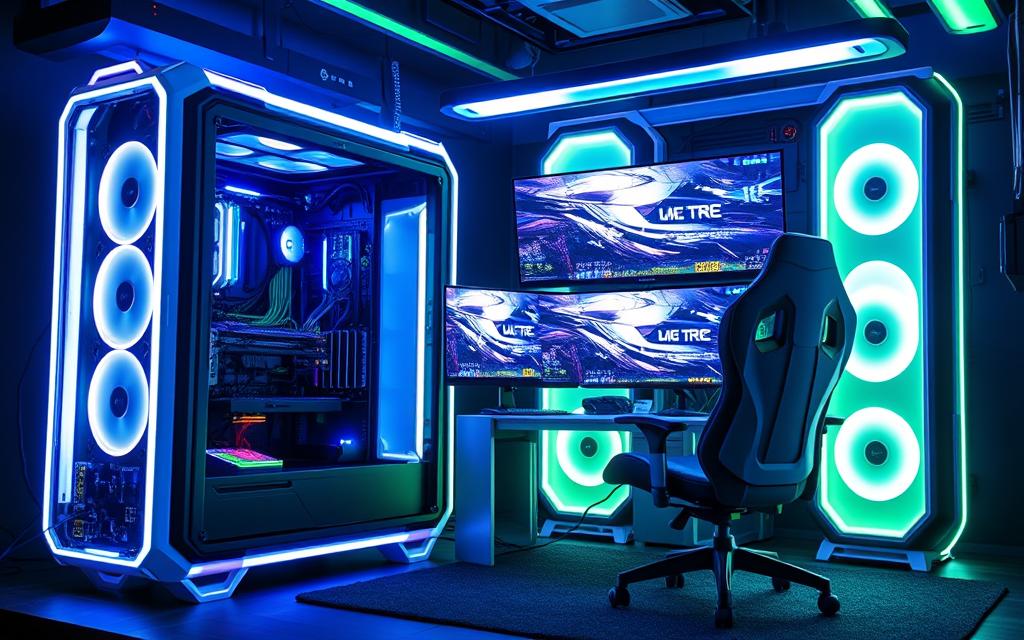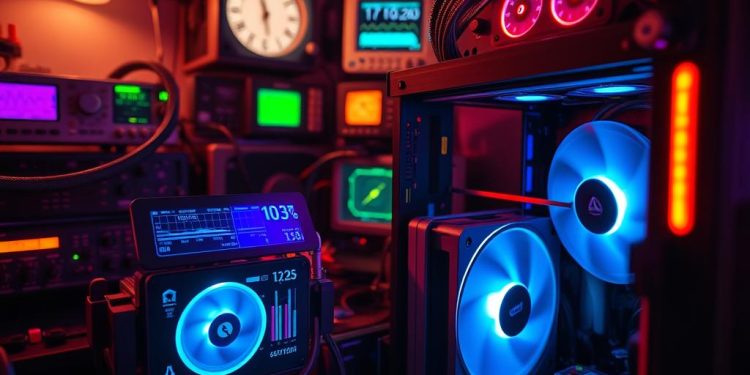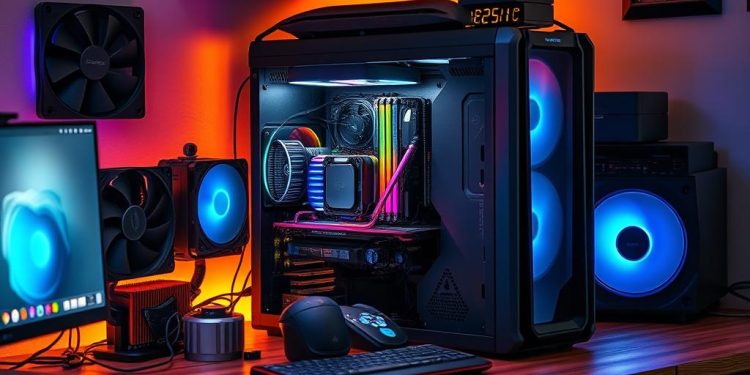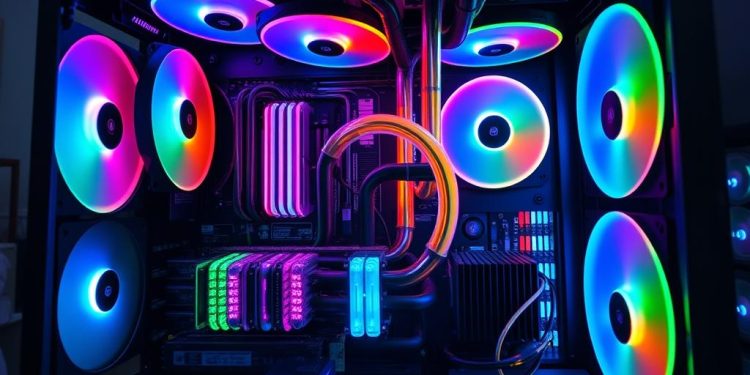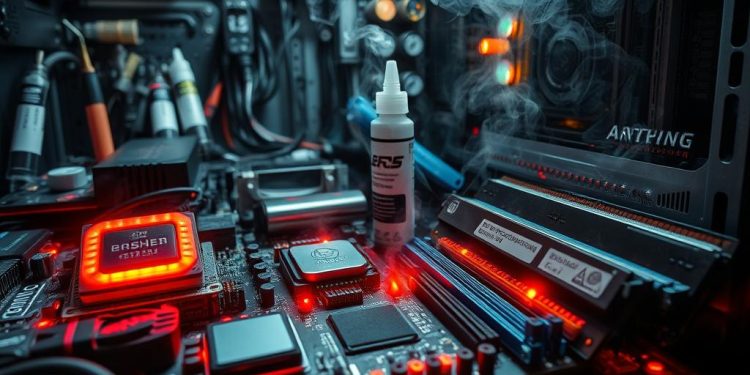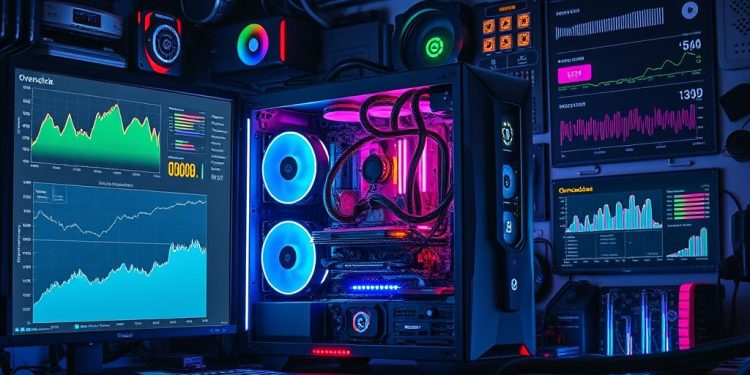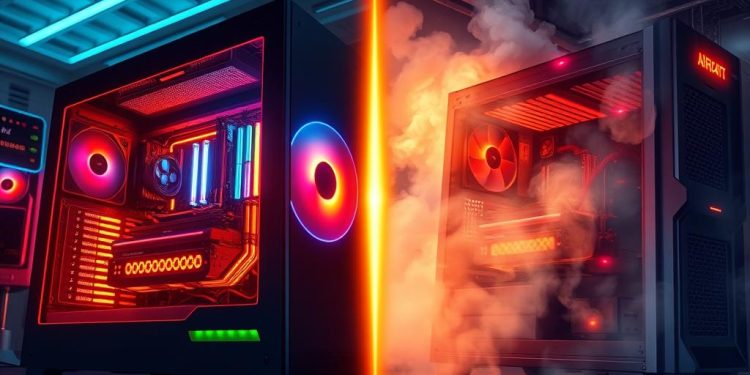If you’re looking to enhance your gaming experience, overclocking for gamers might just be the answer. This process involves pushing your computer’s hardware beyond its factory-set limits, potentially increasing frame rates by 20-30% in intensive gaming scenarios. With the competitive nature of gaming today, a few extra frames per second (FPS) can make a significant difference. By understanding the fundamentals of overclocking and implementing safe practices, you can unlock higher performance levels and enjoy smoother, faster gameplay.
Whether you’re aiming for improved loading times or seeking that edge in online tournaments, overclocking can transform your gaming performance. However, it’s essential to approach this powerful technique with caution to prevent any risks to your system’s stability. In this article, we’ll guide you through everything you need to know about overclocking, from basic concepts to advanced techniques. You’ll discover how to maximize your hardware’s potential without breaking the bank or your system.
Understanding Overclocking: What Every Gamer Needs to Know
Overclocking represents a powerful tool for gamers looking to elevate their gaming performance. By adjusting the clock speed of your CPU or GPU, you can push your hardware beyond its standard specifications. Understanding the fundamentals of overclocking is essential for anyone wanting to harness the potential enhancements it offers in terms of frame rates and overall graphical fidelity.
What is Overclocking?
At its core, overclocking involves increasing the clock speed of computer components like CPUs and GPUs. This adjustment allows your system to operate at a higher performance level, which can translate into faster processing, better graphics, and a more responsive gaming experience. The act of overclocking can lead to significant improvements in frame rates and overall gaming performance by exploiting the inherent capabilities of your hardware. Keep in mind, however, that proper thermal management and high-quality power supplies become critical as you push your components further.
Why Should Gamers Consider Overclocking?
Overclocking can offer multiple advantages for gamers. Achieving higher FPS is a primary reason many players opt for this technique. With an improved clock speed, you may notice up to a 40% reduction in load times and increased responsiveness in games, making competitive gaming sessions much more enjoyable. Here are a few reasons why overclocking matters:
- Enhances CPU and GPU performance, potentially increasing frame rates by 10-30%
- Significantly reduces load times, which can vary between 15-40% depending on the game
- Improves visual quality, offering up to a 75% satisfaction rate among users
- Enables gamers to better compete by adjusting hardware settings for a sharper edge
While the potential gains are notable, remember that overclocking carries risks. Hardware failure, thermal overheating, and voided warranties are all factors to consider before engaging in the practice. Understanding these aspects is essential in making informed decisions to enhance your gaming performance. With careful planning and monitoring, you can take advantage of the benefits while minimizing potential downsides.
The Benefits of Overclocking for Gaming Performance
Overclocking can revolutionize your gaming experience, delivering impressive FPS boosts and enabling smoother gameplay across various titles. By pushing your system’s limits, you unlock a realm of customization and personalization, allowing for a tailored experience that suits your unique gaming style.
Enhanced FPS and Smoother Gameplay
Overclocking significantly improves frame rates, often exceeding the critical 60 FPS threshold essential for a responsive gaming experience. In fast-paced genres, these FPS boosts enhance your ability to react swiftly, potentially transforming your gameplay. Competitive gamers frequently note a performance increase of 5-10%, translating to smoother gameplay and a clearer advantage over opponents.
Cost-Effective Performance Boosts
Investing in new hardware can be costly. By opting for overclocking, you can achieve substantial performance improvements without the hefty price tag. This approach prolongs the life of older systems, potentially delaying necessary hardware upgrades by years. The results can mirror those of high-end components while remaining budget-friendly.
Customization and Personalization
Overclocking allows you to tailor system performance to meet your preferences, giving you control over settings that can dramatically enhance your gaming experience. This level of customization means you can prioritize FPS over graphics settings or vice versa, depending on the game and your play style. Below is a comparison table highlighting some key benefits of overclocking:
| Aspect | Standard Configuration | Overclocked Configuration |
|---|---|---|
| FPS Performance | Up to 60 FPS | Up to 20-30% increase |
| Loading Times | Standard Load | Reduced loading times by 10-15% |
| System Customization | Limited | Highly customizable settings |
| Cost | High for new components | Cost-effective gaming improvements |
CPU Overclocking: Unlocking Your Processor’s Potential
Understanding CPU overclocking can significantly enhance your gaming experience. By increasing your CPU’s clock speed, you can achieve a noticeable performance boost. Begin with familiarizing yourself with key terms and follow a clear guide to optimize your processor’s capabilities safely and effectively.
Key Terminology Explained
When diving into CPU overclocking, it’s essential to grasp various terms that play a pivotal role in the process. Here are some key concepts:
- Clock Speed: This refers to the frequency at which your CPU operates, typically measured in GHz. Overclocking can elevate this speed, as seen in improvements from 3.6 GHz to 4.6 GHz, a substantial 28% increase.
- Thermal Throttling: This occurs when the CPU reduces its clock speed to prevent overheating, which can hinder performance during intense gaming sessions.
- System Stability: Ensuring your system remains stable is crucial when adjusting clock speeds. Inadequate stability can lead to issues like crashes or data loss.
Step-by-Step Guide to CPU Overclocking
Ready to take the plunge into CPU overclocking? Follow this step-by-step guide:
- Enter BIOS/UEFI: Restart your computer and access BIOS/UEFI settings by pressing the designated key during boot-up.
- Adjust CPU Multiplier: Locate the CPU multiplier settings and increase the value. This adjustment raises your CPU’s clock speed. Start conservatively.
- Tweak Voltage Settings: Depending on your CPU, you may need to modify the voltage settings, ranging from 1.25 volts (default) to 1.4 or 1.5 volts, to achieve desired speeds.
- Save Changes: After making adjustments, ensure you save your modifications before exiting BIOS/UEFI.
- Stress Test: Employ stress testing software like Prime95 for a minimum of one to two hours to verify system stability. This step is essential for maintaining performance during gaming sessions.
- Monitor Temperatures: Regularly check your CPU temperature, considering that safe operating temperatures range between 40–65°C (104–149°F).
Remember, the goal of CPU overclocking is to enhance your gaming performance without compromising system stability. Careful adjustments and monitoring will lead to an optimized experience.
| Parameter | Standard Value | Overclocked Value |
|---|---|---|
| Clock Speed | 3.6 GHz | 4.6 GHz |
| Voltage Settings | 1.25 V | Up to 1.5 V |
| Safe Operating Temperature | 40–65°C | Monitor closely |
| Stress Test Duration | 1 hour | 2 hours recommended |
GPU Overclocking: Elevate Your Graphics Performance
GPU overclocking plays a crucial role in enhancing your graphics performance, allowing you to maximize frame rates and enjoy smoother gameplay. Before diving into the actual overclocking process, it’s essential to consider a few key factors to ensure a successful experience.
Essential Considerations for GPU Overclocking
When engaging in GPU overclocking, paying attention to heat management is vital. Increasing clock speeds generates additional heat, which can negatively impact your system if not properly managed. Follow these guidelines to maintain optimal performance:
- Evaluate your cooling system and ensure that it provides sufficient airflow to your GPU.
- Consider upgrading to high-quality cooling solutions if your current setup seems inadequate.
- Regularly clean your GPU and surrounding components to prevent dust buildup, which can hinder cooling efficiency.
How to Overclock Your GPU Safely
Utilizing software tools like MSI Afterburner simplifies the process of GPU overclocking. Begin with incremental adjustments to clock speeds, starting with a core clock rate increase of about 5%. For memory, an increase of up to 10% is often suggested:
- Open MSI Afterburner and gradually adjust the core clock speed in increments of 10-20 MHz.
- After each adjustment, run stress tests using benchmarks like 3DMark or FurMark to monitor system stability.
- Keep a close eye on temperatures—ideally, the GPU should remain below 85 degrees Celsius to prevent throttling.
Incremental tuning allows for stable performance enhancements without pushing your GPU too hard. If the system crashes or freezes, revert your changes by decreasing the clock speed by 10-20 MHz. Following these safe overclocking practices can lead to impressive gains in graphics performance, providing you with a superior gaming experience.
Safe Practices for Overclocking Your Gaming Rig
Maintaining a reliable and high-performing gaming system requires attention to safe overclocking practices. Since overclocking can lead to increased heat generation, implementing effective thermal monitoring and cooling solutions is critical. Here are essential practices to consider.
Thermal Monitoring Techniques
Utilizing thermal monitoring software helps you keep an eye on the CPU and GPU temperatures during operation. Tools like HWMonitor and MSI Afterburner provide real-time data on temperature, voltage, and clock speeds. Regular checks ensure your components stay within safe limits. It’s essential to remember that exceeding 80°C (176°F) for CPUs can lead to instability and damage.
Cooling Solutions: Preventing Overheating
Investing in high-quality cooling solutions is necessary during overclocking. You can choose from a variety of setups, including:
- Air coolers, which offer good performance and cost-effectiveness.
- Liquid cooling systems, ideal for higher-end rigs where cooling demands are greater.
- Applying thermal paste properly, enhancing heat transfer efficiency.
These methods help manage the additional heat produced during overclocking, ensuring your system operates smoothly.
Regular Maintenance Tips
Routine maintenance plays a vital role in sustaining your gaming rig’s performance. Regularly cleaning fans and internal components prevents dust buildup, which can obstruct airflow. Reapplying thermal paste every few years is also advisable to maintain optimal heat dissipation. Keeping your rig clean contributes to the effectiveness of your cooling solutions and enhances thermal monitoring efficiency.
Overclocking Tools for Gamers: Essential Software & Hardware
To effectively overclock your gaming rig, you need both reliable software for gamers and robust hardware. The right combination of overclocking tools can help you unlock your system’s full potential while ensuring stability and performance improvements.
Best Software for Overclocking
Choosing suitable software can make a significant difference in your overclocking experience. Here are some of the top programs utilized by gamers:
- MSI Afterburner: Widely used for GPU overclocking, it provides a user-friendly interface and real-time monitoring data.
- CPU-Z: This essential tool offers detailed information on CPU performance and has been a cornerstone in the overclocking community for nearly 25 years.
- Intel Extreme Tuning Utility: Known for its CPU stress tests, it helps ensure stability during the overclocking process.
- Prime95: This software is recommended for stress testing your overclocks, with a testing duration of 12 to 24 hours to verify system integrity.
- HWMonitor: It tracks vital metrics like CPU and GPU temperatures, providing essential feedback during your overclocking attempts.
- AIDA64 Extreme: Perfect for stability testing, this benchmark tool helps evaluate system performance across various components.
- GPU-Z: This program is perfect for identifying key specifications and performance metrics for your GPU.
Hardware Requirements for Successful Overclocking
Hardware plays a significant role in your overclocking endeavors. Here are essential components to consider:
- Power Supply Unit (PSU): A robust PSU is crucial, as overclocking increases power demands, necessitating reliable performance.
- Quality Cooling Systems: Overclocked CPUs can generate substantial heat, requiring thermal solutions rated for 20-40% above standard operating temperatures to prevent overheating.
- Compatible Motherboards: Ensure your motherboard supports necessary BIOS options for easy adjustments, particularly if utilizing ASUS or ROG hardware.
Incorporating these overclocking tools and adhering to hardware requirements can significantly enhance your gaming experience, yielding higher frame rates and improved load times.
Conclusion
Overclocking is a powerful technique that offers significant overclocking benefits, allowing you to elevate your gaming performance and enhance FPS without needing a hardware upgrade. By grasping the basics and following safe practices, you can achieve remarkable improvements in your gaming experience.
As indicated by research, gamers who engage in overclocking can expect performance boosts of 15-25% in FPS, making gameplay smoother and more responsive. Additionally, understanding the importance of proper thermal management and stress testing can help ensure system stability, reducing risks associated with overheating and instability issues.
As the gaming landscape continues to advance, mastering the art of overclocking will help you stay competitive, allowing you to maximize every gaming session. Whether it’s enhancing graphics settings or reducing load times, the right approach to overclocking can truly transform your rig into a more formidable gaming machine.

